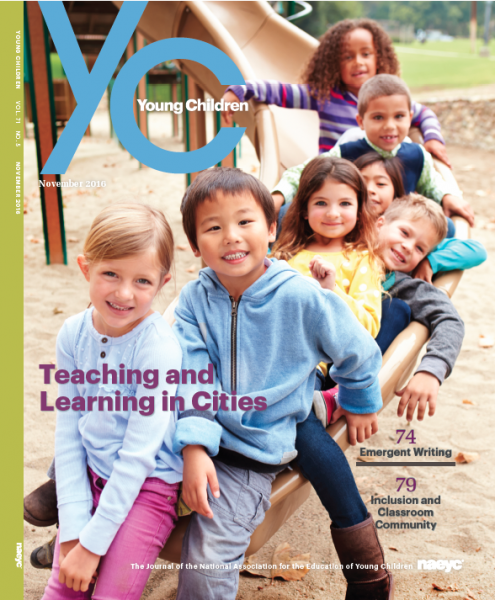Seven Ideas for Early Childhood Educators Teaching in Cities

This blog post introduces the cluster (themed group of articles) for the November issue of NAEYC's journal, Young Children.
Urban educators share many of the same joys, rewards, and challenges as their peers in suburban and rural areas, and yet there are also unique aspects to teaching in urban environments. Paying attention to the nuances of the context in which children learn and live is part of developmentally appropriate practice. I was reminded of this on my way to work one day, thinking about the cluster for this issue of Young Children.
Walking on a busy sidewalk in Washington, DC, I nearly walked into a caterpillar emerging from its husk as it dangled from a tree—an unexpected encounter with nature in the city. As pedestrians hurried by, I called out, “Watch out for the caterpillar!” so they would avoid running into it. I thought about how differently we experience nature in a city than in a rural or suburban area with less foot traffic—a good reminder about how important it is for educators to think about the specific context in which they teach and children learn.
In this issue of Young Children, we share seven stories of best practice, innovative ideas, and new research related to teaching young children in urban programs. From teaching STEM skills to preparing teachers to support children’s positive racial identities, the articles offer many lessons learned—food for thought to inspire all educators.
Using STEM to Solve Community Problems
Second-graders in a Boston public school brainstormed how to solve a problem they observed in their community—too much trash on the playground.
As they developed solutions through inquiry, they learned and explored key concepts related to science, technology, engineering, and math. Find out more in “Community-Based Engineering: STEM Experiences From a Second Grade Urban Classroom,” by Tejaswini Dalvi, Kristen B. Wendell, and Joseph Johnson.
Supporting positive racial identities—New research
Two recent reports from the University of Pittsburgh—one from its Center for Urban Education and one from its Office of Child Development—highlight the role societal racism plays in denying students of color the opportunities needed to thrive in school and the importance of helping children develop positive racial identities at a very young age. Read about this in Ira E. Murray and Adam Alvarez’s article, “Research to Practice: New Research on Helping Children Develop Positive Racial Identities.” Highlighting teachers’ voices Hear about the hopes, challenges, and successes of a master preschool teacher and instructional coach in San Antonio, an arts educator in the Bronx, and an early childhood educator and guest lecturer in San Francisco, in “Three Cities, Three Educators,” by Cristina M. Lopez, Isauro M. Escamilla Calan, and Hector Rivera.
Preparing new teachers for urban classrooms
All new teachers need mentoring and guidance, but these supports are critical in urban public schools, which have significantly low teacher retention rates. Lea Ann Christenson describes a partnership between Towson University and Baltimore’s Department of Education that provides supports to bolster the success of new teachers in Baltimore schools, in “Preparing Preservice Teachers to Support Young Children in Urban Settings.”
Supporting dual language learners
Karen N. Nemeth discusses some trends impacting city schools, including an increasing concentration of children and families with many different home languages—some the schools have never before supported. She offers examples of best practice in “Extreme Diversity in Cities: Challenges and Solutions for Programs Serving Young Children and Their Families.”
Building strong relationships with all children
In “Culturally Responsive Strategies to Support Young Children With Challenging Behavior,” Charis Price and Elizabeth A. Steed share five strategies that teachers can draw on as they establish nurturing practices to help all children engage in positive, prosocial interactions with teacher and peers. These relationship-building techniques are particularly relevant for teachers as they reflect on their own practices and biases, specifically toward African American boys.
Calling on community stakeholders
In this Viewpoint, “Building a More Inclusive Sandbox: Inviting New Collaborators to Support Children, Families, and Early Learning,” Titus DosRemedios encourages educators to bring together diverse professionals from different fields—librarians, public housing administrators, pediatricians, bankers, parent leaders, and educators—to expand early learning opportunities for children in their communities.
As always, we’d love to hear from you. Send us a note with your thoughts on this issue at [email protected].
Susan Friedman is Senior Director, Publishing and Professional Learning at NAEYC.